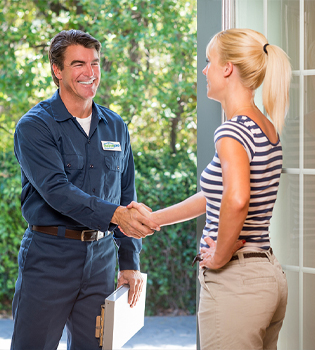
A malfunctioning thermostat can be frustrating for any homeowner. One of the most common reasons a thermostat may not work is due to a lack of proper power connection. This can stem from issues such as dead batteries or a tripped circuit breaker.
Another possible cause is a wiring problem, where loose or corroded wires prevent the device from functioning correctly. If the thermostat isn’t correctly calibrated or positioned, it could also result in inaccurate temperature readings.
Sometimes, the issue might be as simple as a dirty thermostat that needs cleaning. Dust and debris can interfere with its sensors and components, leading it to malfunction. Regular maintenance and a quick check of these potential problems can often resolve the issue swiftly.
Identifying Common Thermostat Problems
Thermostat issues can often cause discomfort in your home by affecting your heating and air conditioning systems. Recognizing common problems with your thermostat can help you find quick solutions without extensive troubleshooting.
Thermostat Not Turning On
A thermostat not powering up might indicate an electrical issue. Check the battery levels if you’re using a battery-operated unit. Dead or low batteries are a common cause of a thermostat failing to turn on. For wired thermostats, ensure the circuit breaker is not tripped.
Inspect the wiring connections inside the thermostat. Loose or frayed wires can prevent it from functioning properly. It’s beneficial to consult the thermostat’s manual to verify correct wiring configurations.
Incorrect Temperature Readings
Incorrect readings can cause your heating or cooling system to run inefficiently. First, check if the thermostat is placed in a poor location. Placing it near heat sources, windows, or drafty areas can affect its accuracy. Calibration issues might also be the culprit. Most thermostats have a calibration setting that can be adjusted. If the device is old or has not been calibrated in a while, it might need professional maintenance or replacement.
Thermostat Not Responding to Settings
If your thermostat is not adjusting your heating or cooling system as expected, there could be multiple reasons. Ensure the system mode (heat, cool, auto) is correctly set. Misconfiguration can lead to non-responsiveness.
Compatibility issues with your HVAC system might also be to blame. Older HVAC systems might not support modern thermostats or vice versa. Software updates may be needed if it’s a smart thermostat.

Essential Troubleshooting Techniques
When faced with a malfunctioning thermostat, key troubleshooting techniques include checking the power source and wiring, resetting the device, and replacing batteries if needed.
Check Power Source and Wiring
Begin by inspecting the thermostat’s power source. Ensure it is properly connected to the home’s electrical system. If it is battery-operated, verify that the batteries are installed correctly and have charge.
Examine the wiring for any signs of damage or wear. Loose or corroded wires can cause the thermostat to malfunction. Reference the thermostat’s manual for proper wiring configurations.
Reset the Thermostat
Resetting the thermostat can often resolve minor glitches. Locate the reset button, usually found on the front or side of the device. Press and hold the button for 5-10 seconds. This will restore the thermostat to its default settings.
A factory reset can be necessary for severe issues. Consult the user manual for specific instructions on initiating a factory reset. Note that this process will erase all custom settings, so reprogramming may be required.
Replace Batteries
For battery-operated thermostats, maintaining fresh batteries is crucial. Begin by removing the thermostat from its wall mount. Identify the battery compartment and carefully replace the old batteries with new ones.
Use the correct type and size of battery recommended by the manufacturer. Improper batteries can lead to malfunction.
After replacing the batteries, reattach the thermostat to its mount and test the device to ensure it turns on and responds to programmable settings.
When to Seek Professional Help
If the thermostat is completely unresponsive, even after changing the batteries, it’s time to call a professional.
Strange noises coming from the HVAC system could also indicate deeper issues that require expertise.
Certain problems, such as faulty wiring or electrical issues, should never be handled by anyone without proper training.
If the display is blank or dim, it might be more than just a battery issue, necessitating professional inspection.
Repeatedly resetting the thermostat to fix the problem is a sign that a more complex issue might be at play.
Issues like short cycling, where the HVAC system turns on and off rapidly, often require expert intervention.
If aware of an outdated thermostat model, consider consulting a professional for an upgrade.
Problems with smart thermostats, such as software glitches or connectivity issues, might need a technician’s touch.
Discrepancies between the thermostat’s set temperature and the actual room temperature indicate possible sensor problems that need professional attention.
A professional can ensure all components, like sensors and wires, are functioning correctly and safely.
A licensed technician can provide a thorough inspection and accurate diagnosis, ensuring long-term efficiency and safety.
The Importance of Regular HVAC Maintenance
Regular HVAC maintenance is crucial for the efficient functioning of your heating and cooling systems. By scheduling check-ups, you can extend the lifespan of your units and reduce the likelihood of unexpected breakdowns.
Benefits of Regular Maintenance:
- Improved Efficiency: Clean filters and well-maintained components ensure the system runs smoothly, using less energy.
- Cost Savings: Preventative maintenance can help avoid costly repairs and lower energy bills.
- Enhanced Comfort: Regular servicing keeps your home at a consistent temperature, providing an overall comfortable environment.
Neglecting HVAC maintenance can result in minor issues escalating into major problems. Technicians can spot and address small issues before they compromise the entire system.
Maintenance also includes checking for leaks and ensuring there are no blockages in vents or ducts. This helps in maintaining good indoor air quality by preventing dust and allergens from building up in the system.
Consistent care is not just about immediate benefits; it also adds to the long-term health of the HVAC system. Servicing twice a year, ideally in the spring and fall, prepares the system for peak usage seasons.
Routine maintenance promotes better performance, saving you money and headaches related to malfunctioning systems.

